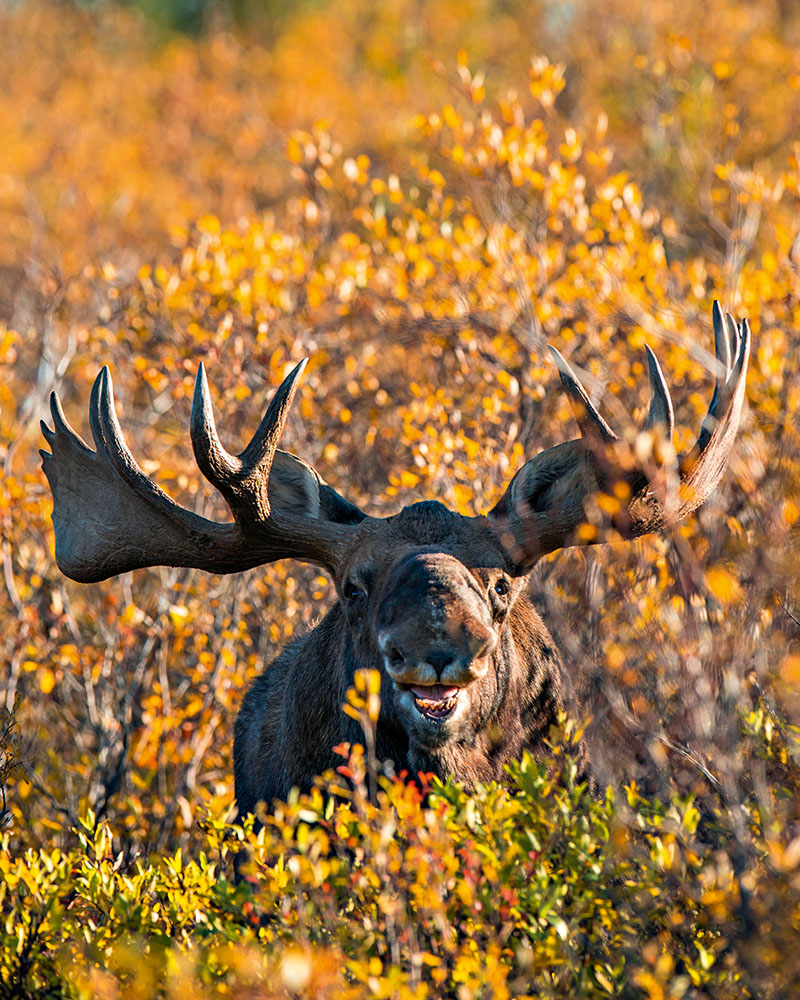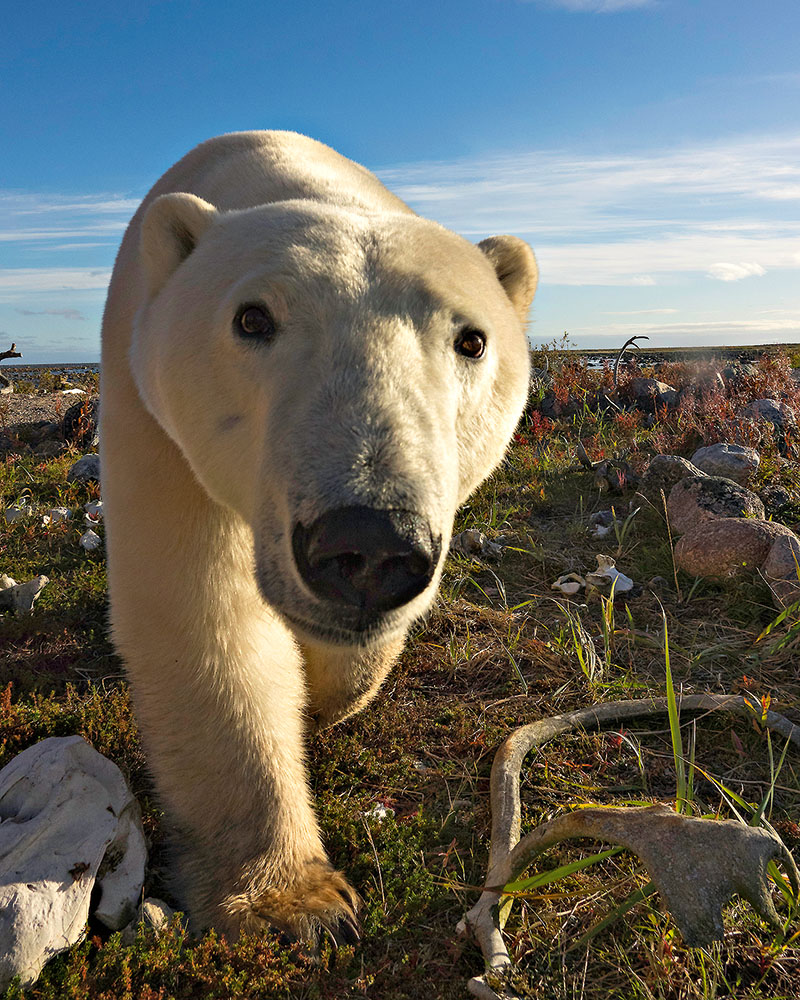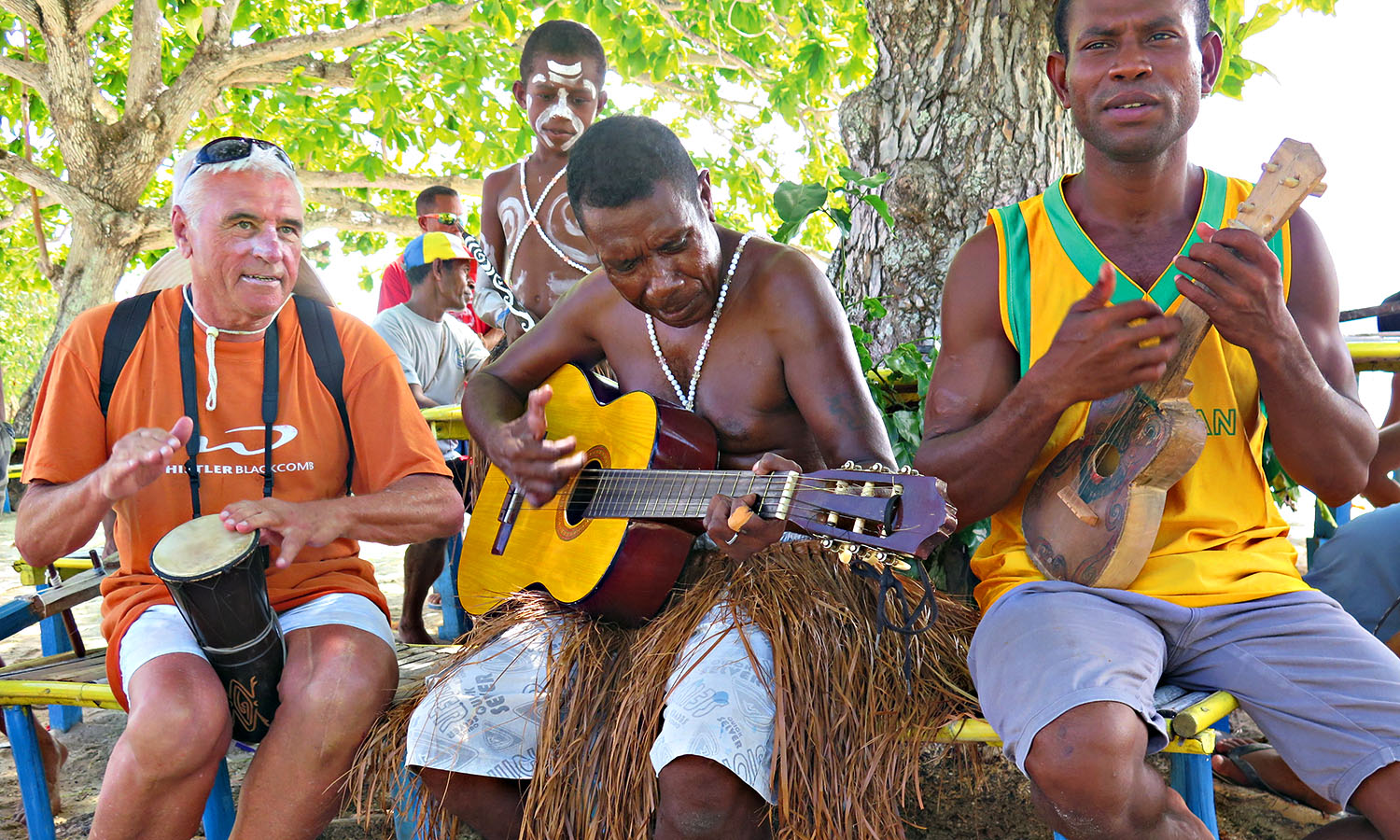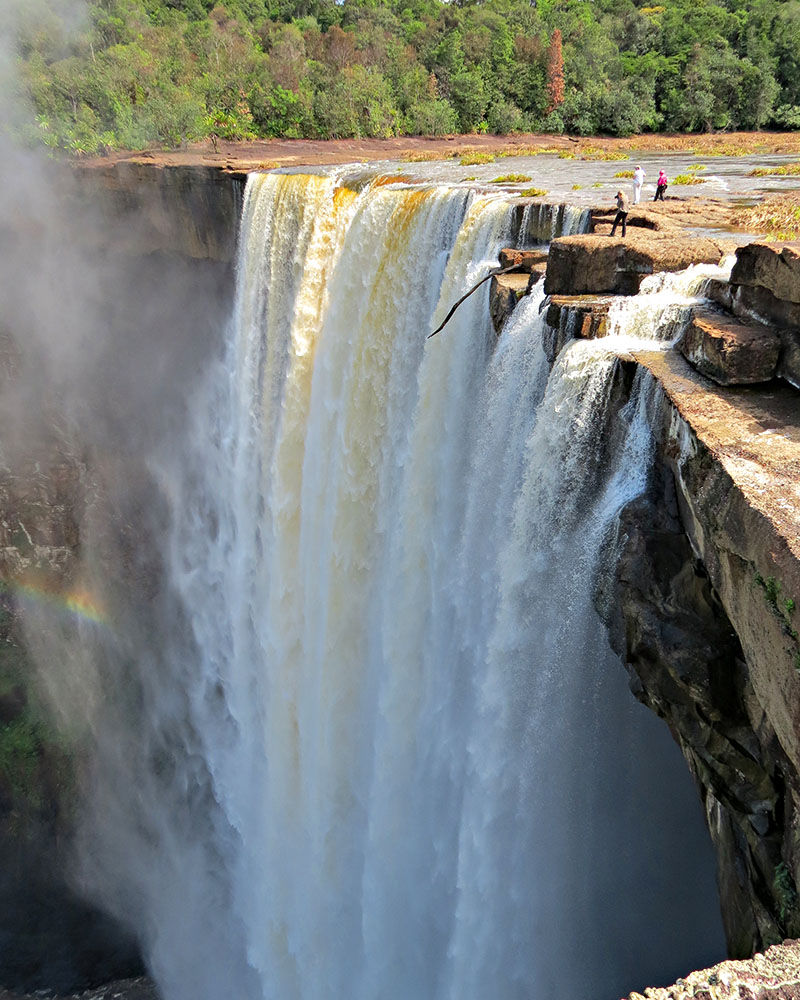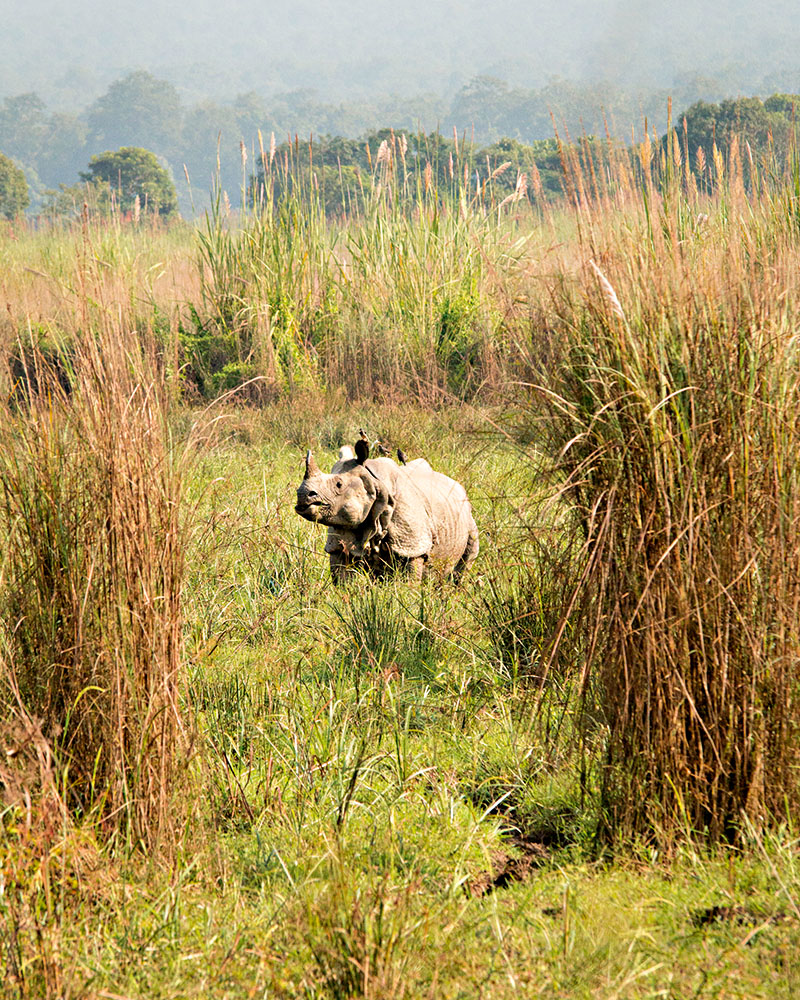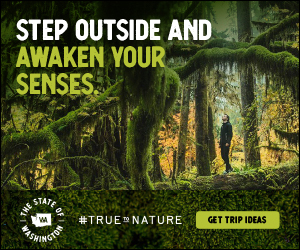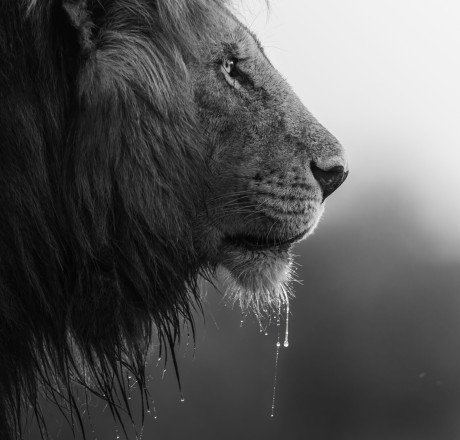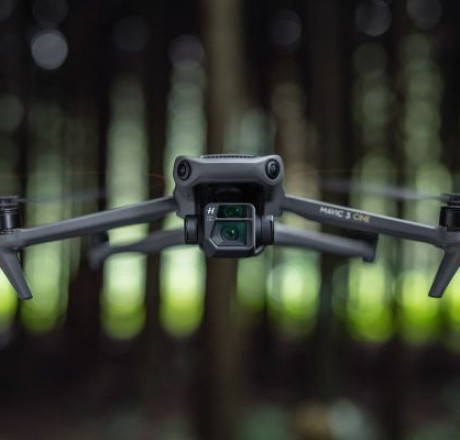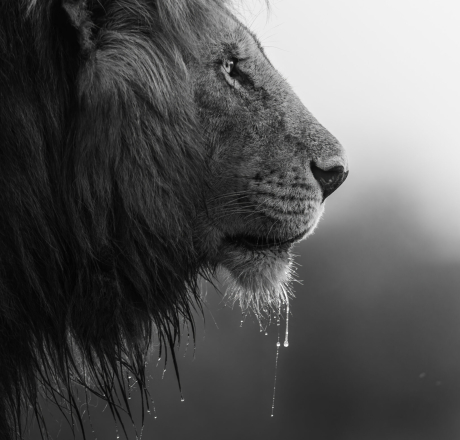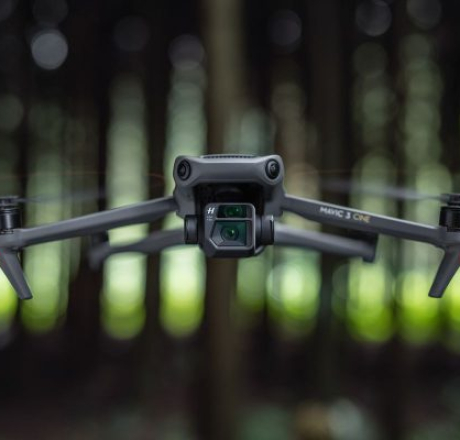World
World
6 Incredible Journeys
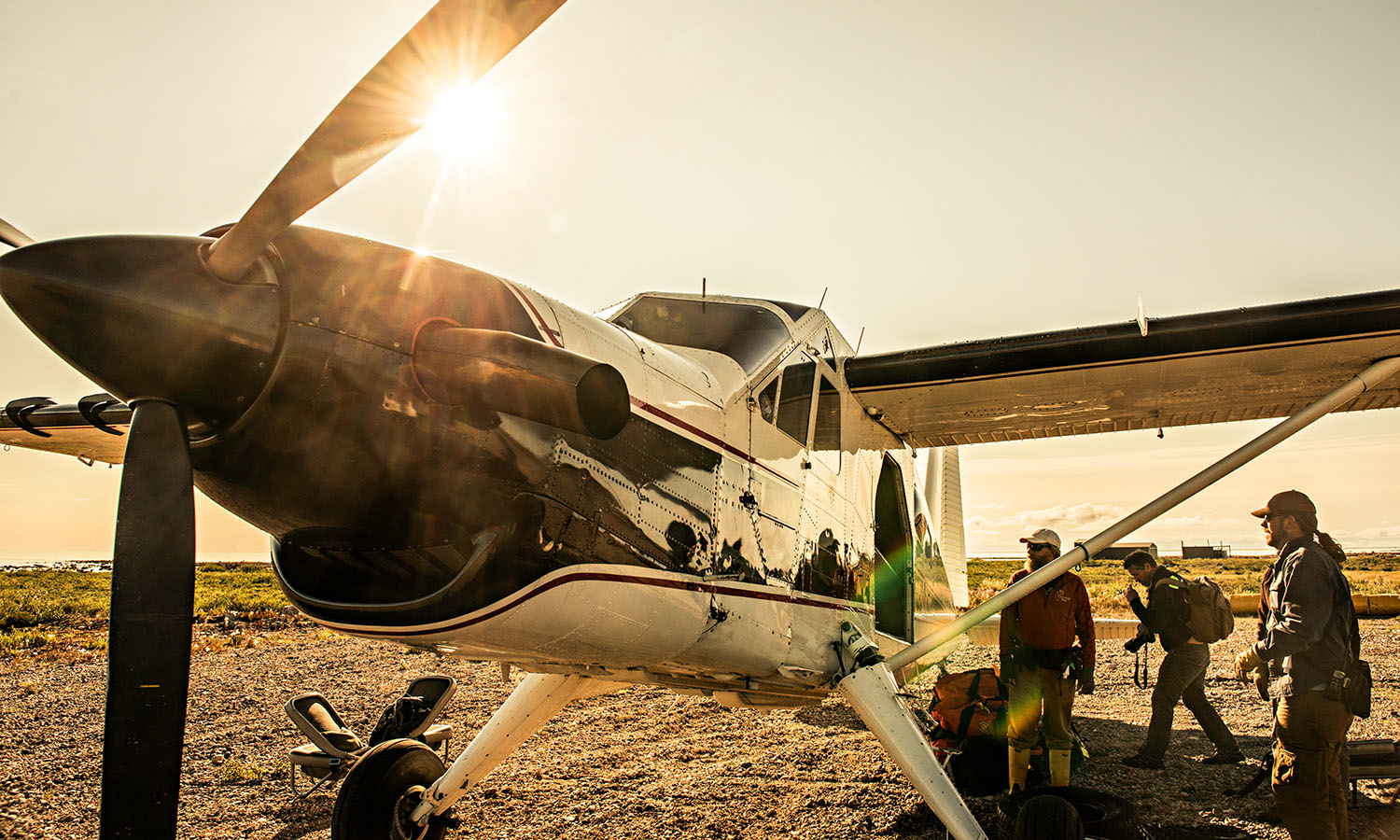

Creatures of the Tundra
Fewer travellers set foot in this remote part of Canada’s Barren Lands each year than on the summit of Mount Everest. Jad Davenport heads to the wilderness, where polar bears and beluga whales reign supreme.
Photography by Jad Davenport
We’re so close to the polar bear I can hear him snoring. Terry Elliot, a guide from the nearby Seal River Heritage Lodge, motions for us to stop walking. It’s late September and blades of sunlight slice across the western shore of Hudson Bay in Manitoba. The bear glows a bright ivory against the autumn tundra.
“He’s missing his buddy,” Terry says. “Males like this one hang out with other young males. It’s called ‘pair bonding’. They’ll spend most of their days sleeping and sparring – practice fighting – until winter comes and they can get back out on the ice to hunt seals again.”
Maybe it’s the mention of seals, but the bear snorts awake and rolls to its feet. I’m suddenly aware of just how big it is and how close we are. I’m six foot, five inches tall. A full-grown male can stand twice my height and outweigh a ’68 Volkswagen Beetle.
I raise my camera when the bear grabs a dwarf willow tree in his jaws and rips it from the ground. Then he tosses the mangled vegetation at us.
“Is he warning us?”
Terry chuckles. “No, that’s his toy. He wants to play with us.”
While I expected to see polar bears from a distance when I arrived at Seal River several days ago, I didn’t expect to be invited into their world. This is one of the reasons the lodge is unique. Founded by a local family with Canadian and Icelandic roots, Seal River and the other four lodges owned by Churchill Wild offer guests a chance to not just see the untamed Arctic but also to immerse themselves in it, bears and all.
For the past three days, my fellow guests and I have been hiking and voyaging by Zodiac along the pristine coast. Polar bear encounters are frequent, but we’ve also howled back and forth with a pack of wolves, tracked caribou, snorkelled with hundreds of singing beluga whales (some so curious they nudged my GoPro) and explored Inuit archaeological sites.


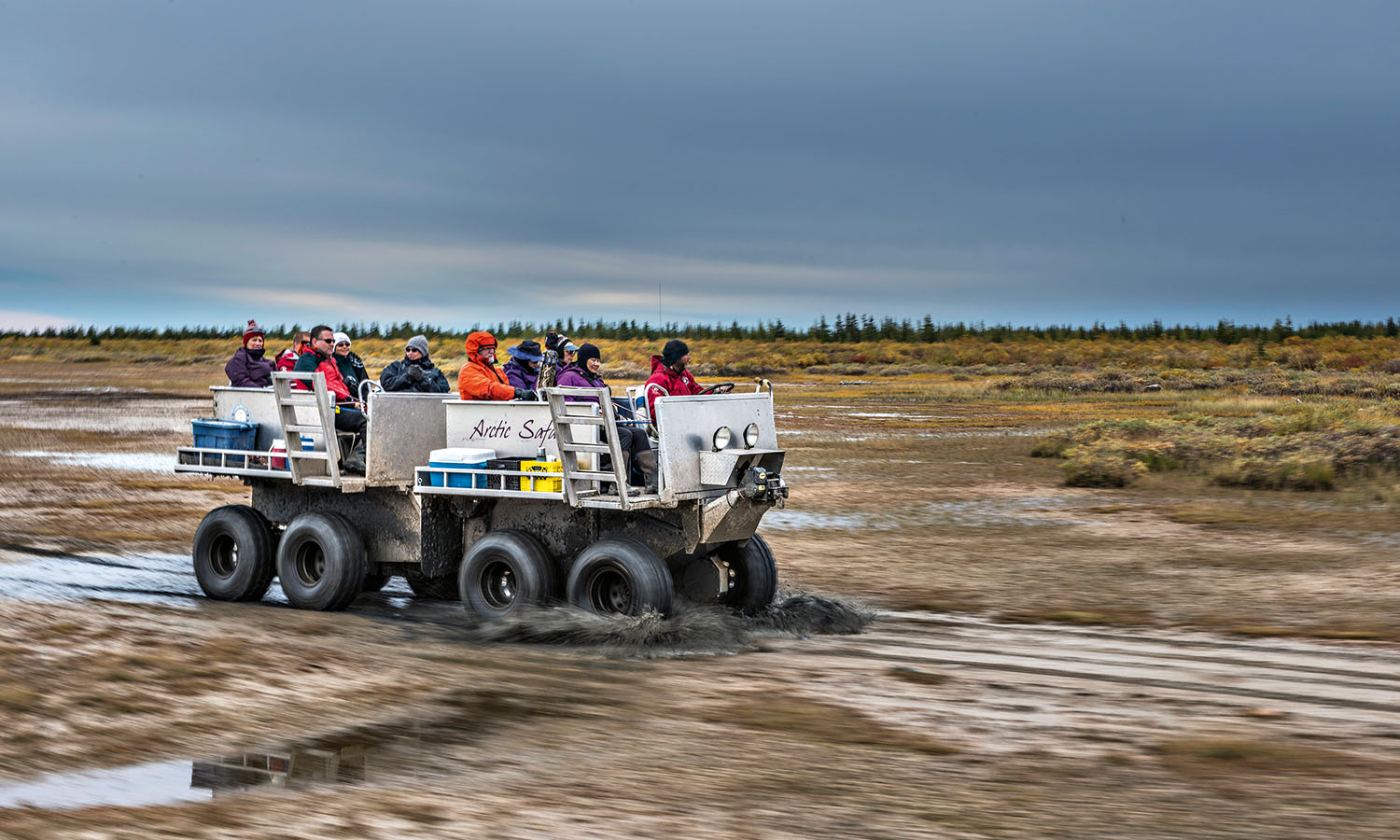

The morning after the playful bear encounter, we leave the lodge behind for an even more remote destination. A de Havilland Otter ferries us nearly 160 kilometres northwest to Tundra Camp, Churchill Wild’s newest outpost. The wildlife here might be sparser – we spot only a family of black bears from the air – but the draw for us is the Barren Lands. This wilderness of stunted pine forests, rolling tundra and sandy eskers has a population smaller than Broome at Christmas.
Tundra Camp sits on the shores of Schmok Lake. The main base is a rustic hunting cabin and a pair of large tents – one for dining and one for briefings and bad-weather lounging. The sleeping camp – a dozen private expedition tents with cots, sleeping bags and propane heaters – is a short walk beyond the cabin.
Our two-night stay at Tundra Camp might be brief, but the remoteness and the silence of the landscape – and the prolonged hours of summer light – make the days long and full. One of the guides, Josh, leads some of the group along the lakeshore to explore the autumn landscape and pick blueberries. I join Terry and two fit South Africans on an all-day trek. There are no trails out here; we simply follow ancient caribou paths and spend hours roaming over the low granite-capped ridges. Each summit offers another never-ending panorama.
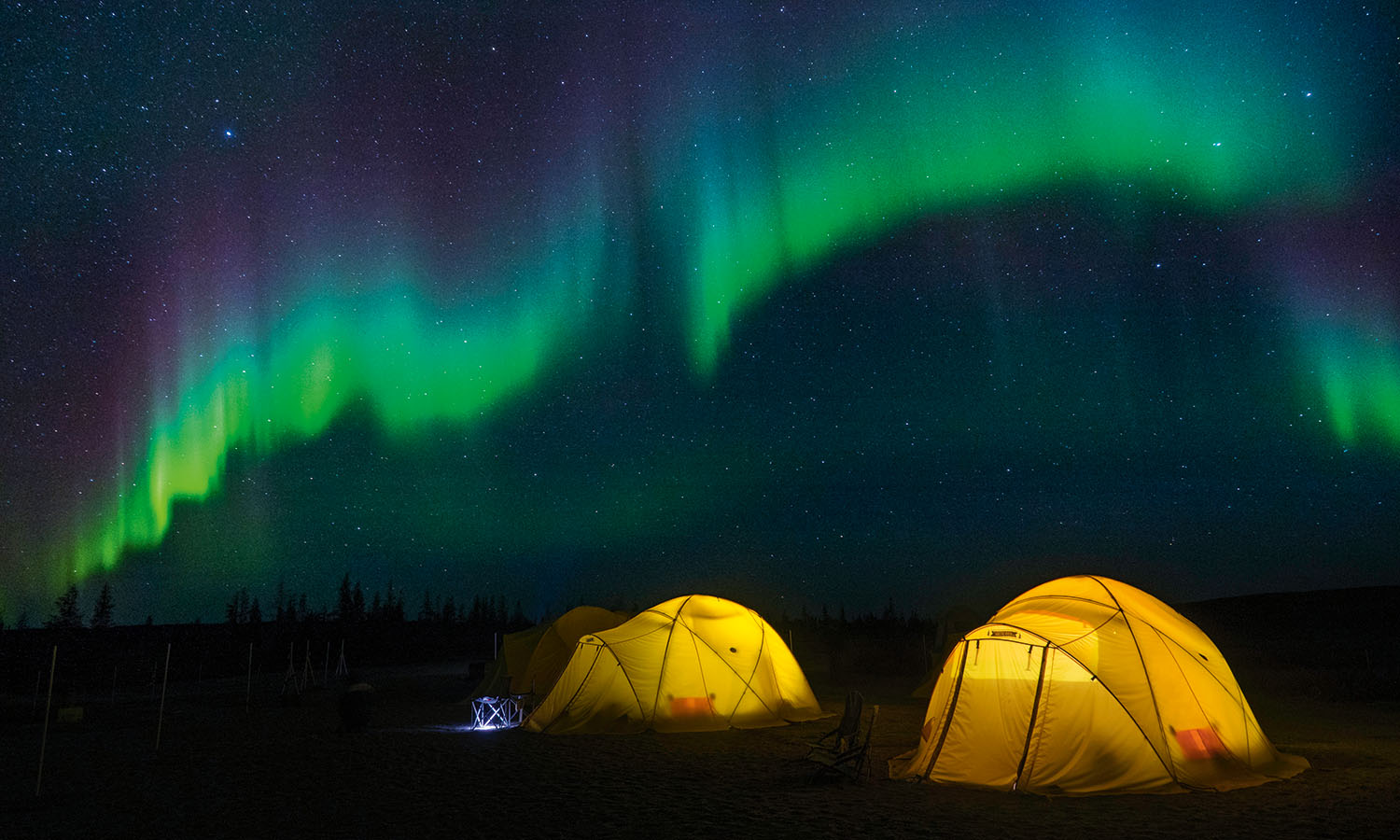

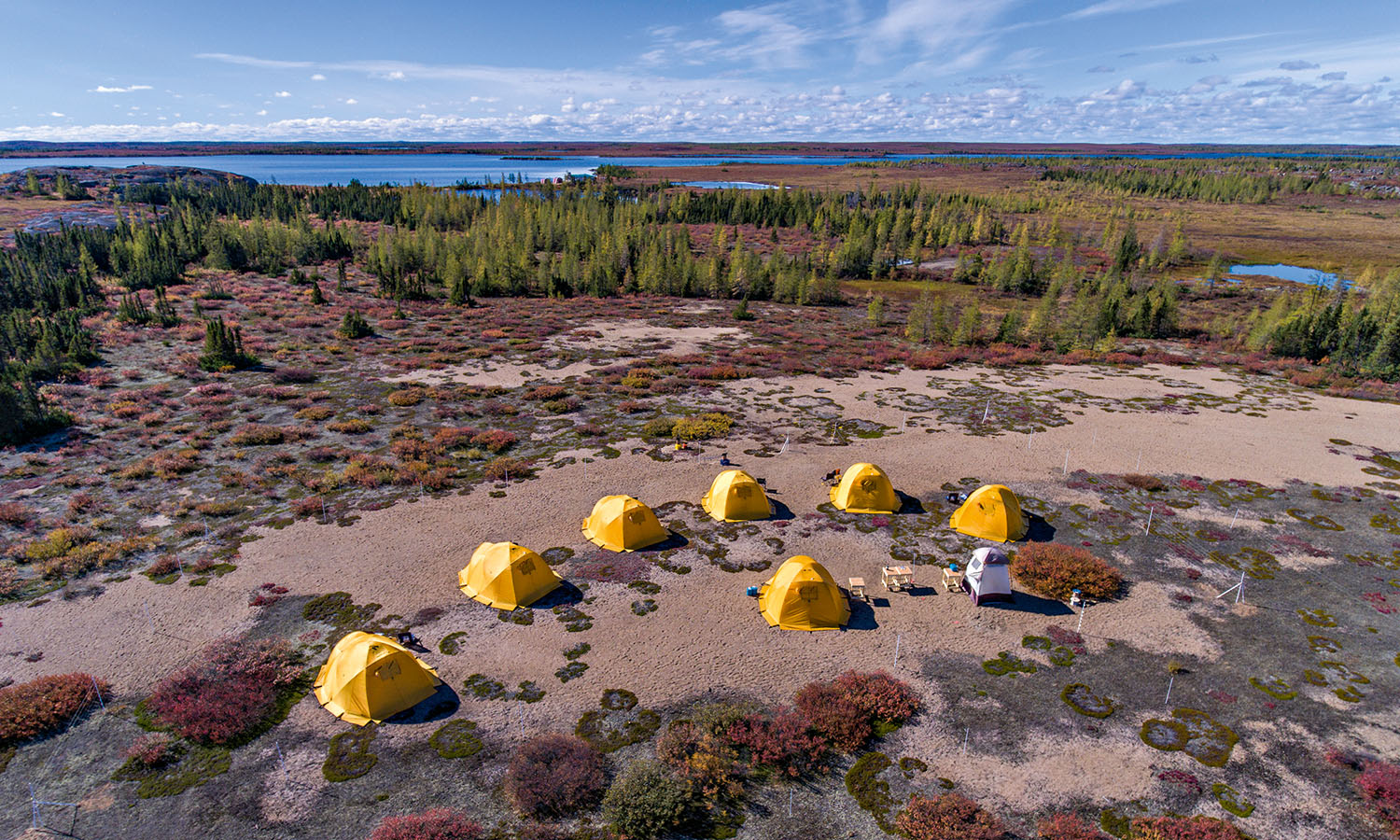

That evening, after moose lasagne and blueberry pie (the French-trained chef has been imported from Seal River), I join everyone around the campfire beside the lake. The sun is down and the Milky Way is starting to materialise. My legs are hammered and my face glows from long days of Arctic sun and wind. I’m hypnotised by the flames. “Look up,” says Terry.
The heavens ripple with tall green and purple curtains: the aurora borealis. We lean back in our chairs. A deep silence falls over us. “The Inuit believe the northern lights are the spirits of their ancestors dancing and playing in the afterlife,” says one of the campers who has travelled in Greenland.
The firewood is gone and the embers cold when we hike back to camp. Before I click off my headlamp and unzip the tent, I look up again. The shimmering spirits are still dancing over the Barren Lands.
Get There
Air Canada flights from Sydney to Winnipeg, where the trip begins, via Vancouver, start at US$1491.
aircanada.com
Tour There
Churchill Wild, a family-run outfitter and member of the Magnificent 7 Wilderness Lodges, offers Arctic and sub-Arctic safaris from July through November at its Seal River Heritage Lodge, which specialises in both polar bear viewing and seasonal snorkelling with belugas. Exclusive safaris combining visits to both Seal River and the new tented Tundra Camp in the Barren Lands are available for two weeks each September. Nine-day trips start at US$8133
churchillwild.com
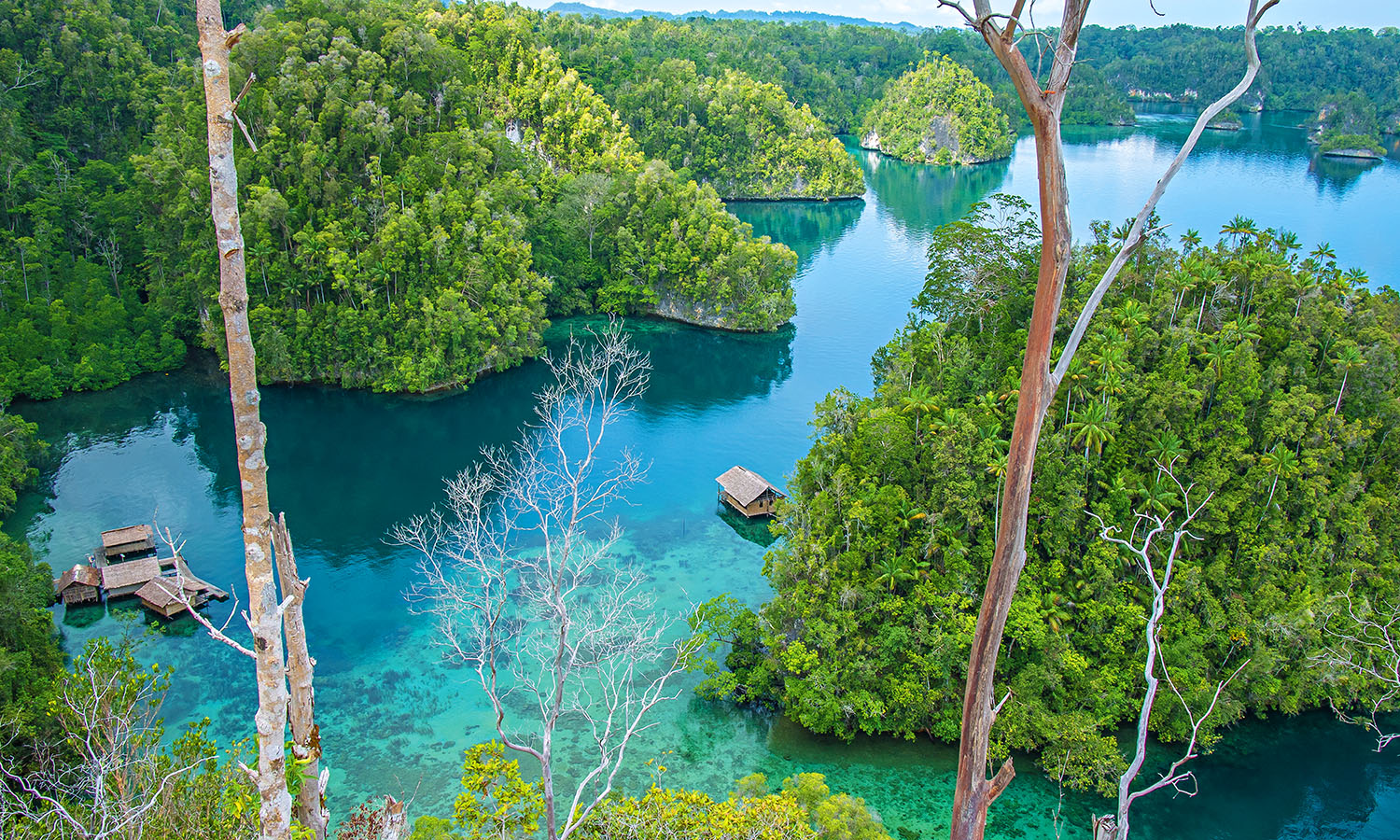

Papua’s Eden
It’s dubbed the last paradise on earth. Keren Lavelle takes to the waters of Raja Ampat to see if this remote archipelago lives up to its reputation.
“OK, everybody,” instructs Aran, our Papuan guide, “move quickly. If you want to see the manta rays, out of the boat now!” We scramble over the edge and the current whisks us away from the vessel. To my surprise, the water is murky with sand – after nearly a week in the snorkelling and diving paradise of Raja Ampat, I take it for granted the water is always going to be silvery, translucent, crystal clear.
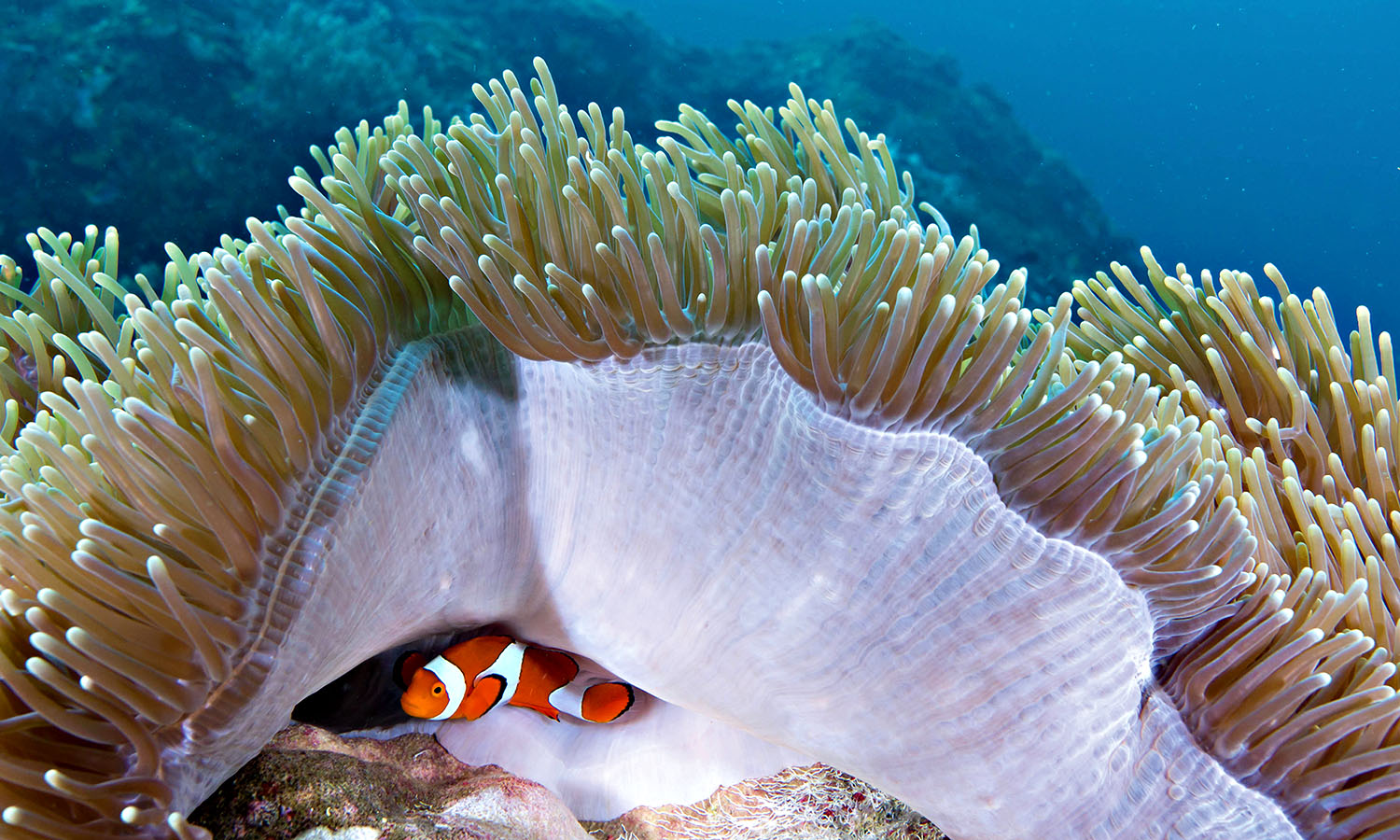

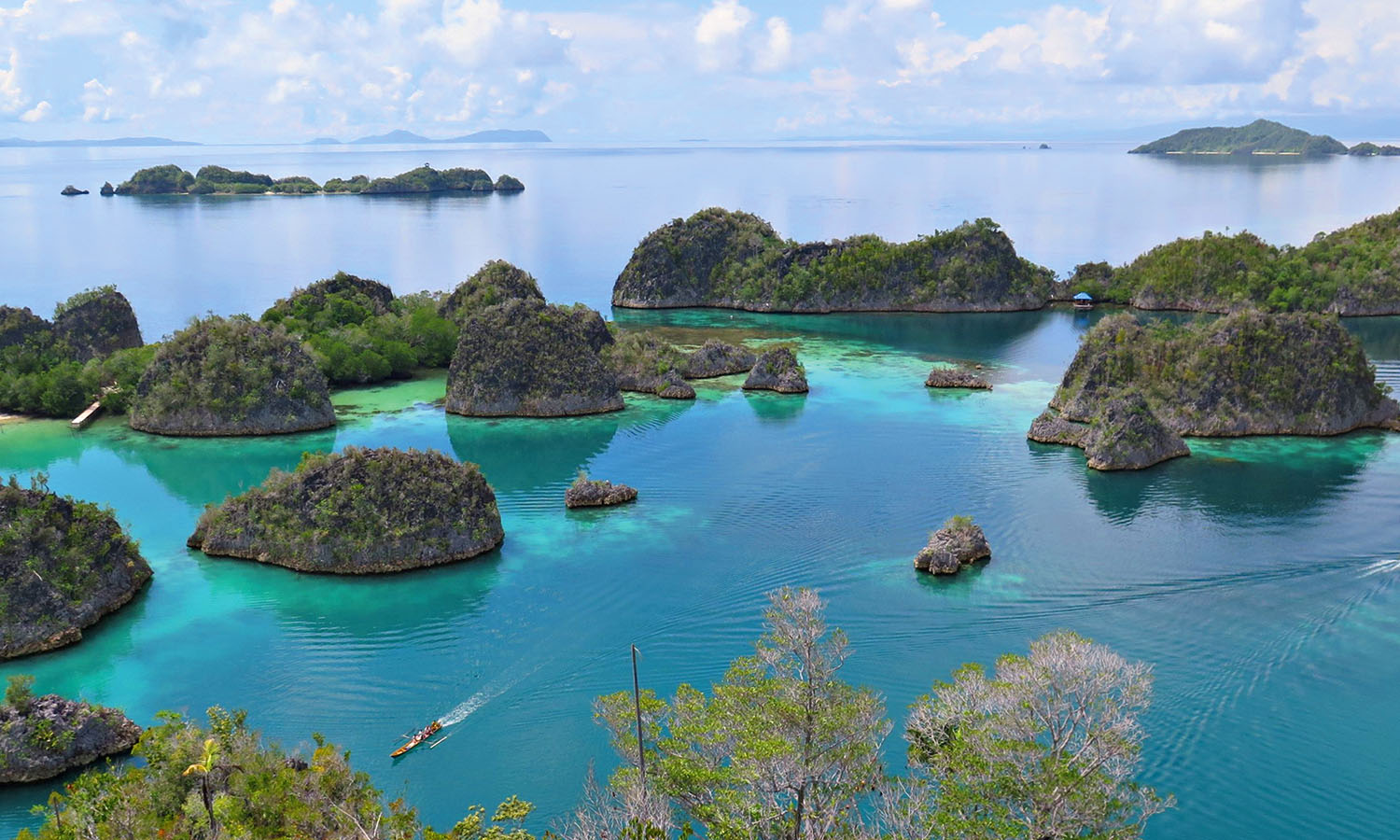

I peer hard through my snorkel mask, but can’t see much more than sunlit water filtered with motes of sand. No fish, and certainly no big black shapes. The best snorkellers in our group are diving down deep, but, one by one, they come up shaking their heads. Where are these elusive mantas?
Just as we are about to give up, Andrew, a bloke from Perth, shouts that he’s spotted them. It’s now a race, all of us swimming as fast as we can in the direction he’s pointed. Soon, I too can see these graceful black and white rays idly flapping below me, turning lazy figures of eight. I’m at Manta Sandy where these oceanic giants gather above a handful of rocks to be groomed of parasites and dead skin by wrasse fish. The mantas’ slow, balletic swoops act as a signal to the fish to come and get it.
Manta Sandy is one of the many fascinating diving and snorkelling spots to be found in the Raja Ampat archipelago – more than a thousand islands scattered over 4.5 million hectares of ocean, off the Bird’s Head Peninsula, Indonesian Papua’s northwest tip. The name Raja Ampat means four kings in Indonesian: a poetic reference to the four largest islands. It is smack-bang in the middle of the Coral Triangle, which stretches up from the Great Barrier Reef, taking in Papua New Guinea, the Solomon Islands and parts of Indonesia, Malaysia and the Philippines. Raja Ampat is considered to be the richest marine environment of them all, containing 75 per cent of the world’s coral species and around 1500 species of fish.
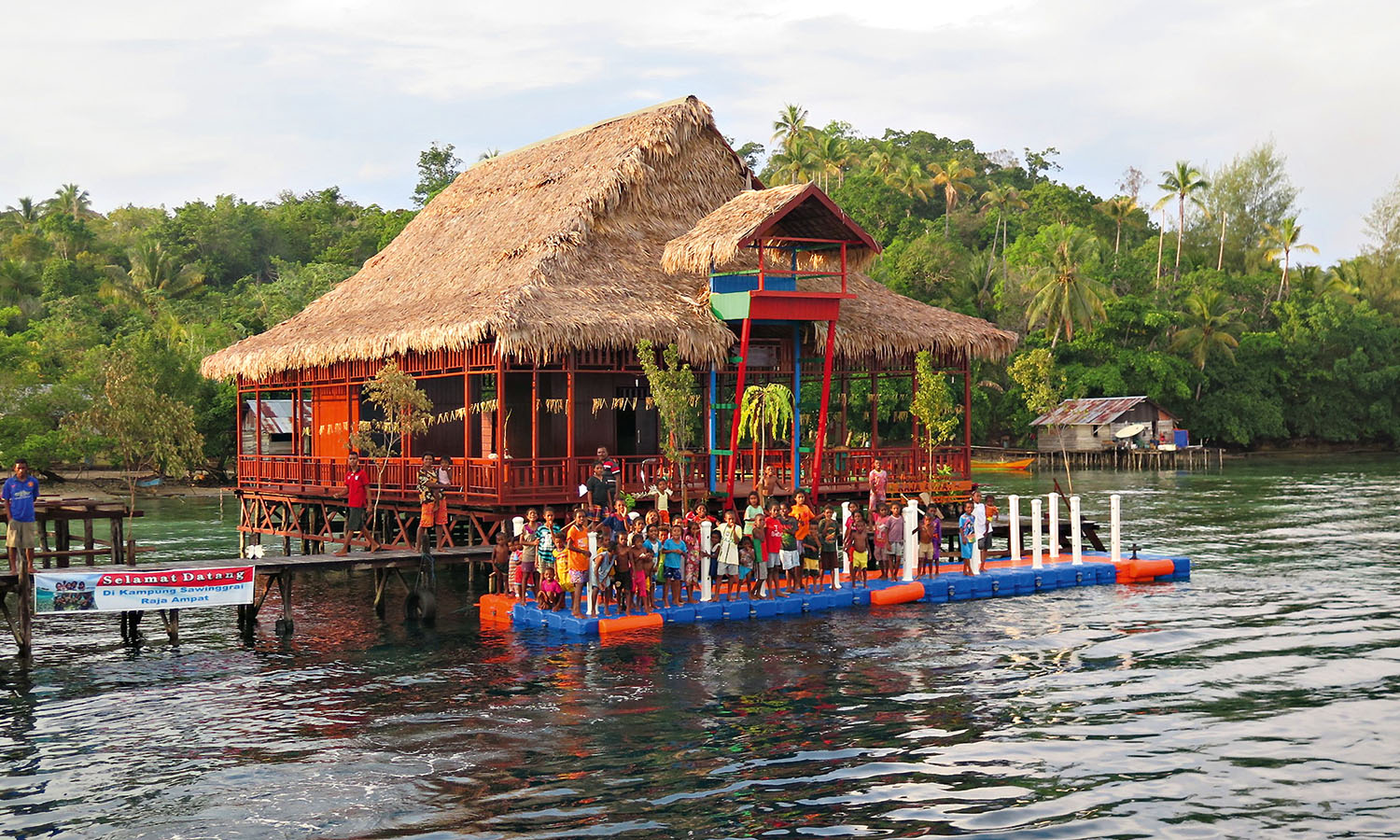

During our week here, we are treated to several very special snorkelling destinations – all so good I’d be hard-pressed to pick a favourite. Is it the almost-pristine home reef just off the jetty at the Raja Ampat Dive Resort on Waigeo Island? Or perhaps the sandy beach on Yeben Island, where lionfish wave their airy fins as brilliant blue fish dash by? Or Mioskon Reef, where grouper, clown and parrotfish dart around corals wrinkled like oversized brains?
Near Mioskon, we swim into a limestone cave and clamber up a slippery clay slope in order to see a stalagmite shaped like a male member. “What do you call this place?” someone asks. “Penis cave,” replies Aran, not batting an eyelid. Huge schools of fish move as one in the fabulously clear water off the jetty at Sawinggrai Island, where some creatures seem to swim up just to pose for my camera. The spectacular reef cliff of Friwen Bonda boasts enormous red fan corals and fairytale mushroom-shaped ones, but I scrape my foot on a fan, so I can’t choose this as my favourite. With this many options you can afford to be ruthless.
If, as well as superb marine environments, you like a frisson of adrenaline with your aquatic adventures, you can certainly get it here. These islands are in the zone of the Indonesian throughflow, the name given to the vast volumes of water that move between the Pacific and the Indian Oceans. On our second day in Raja Ampat, we travel through the passage between Waigeo and the island of Gam in Kabui Bay. It’s so narrow it feels as if we are on a river, with mangroves on either side. The current flowing through the strip can be so strong, says Aran, that “if you’re in the water and stretch out your arms, you’ll be flying like Superman”. Imagine moving as fast as a fish.
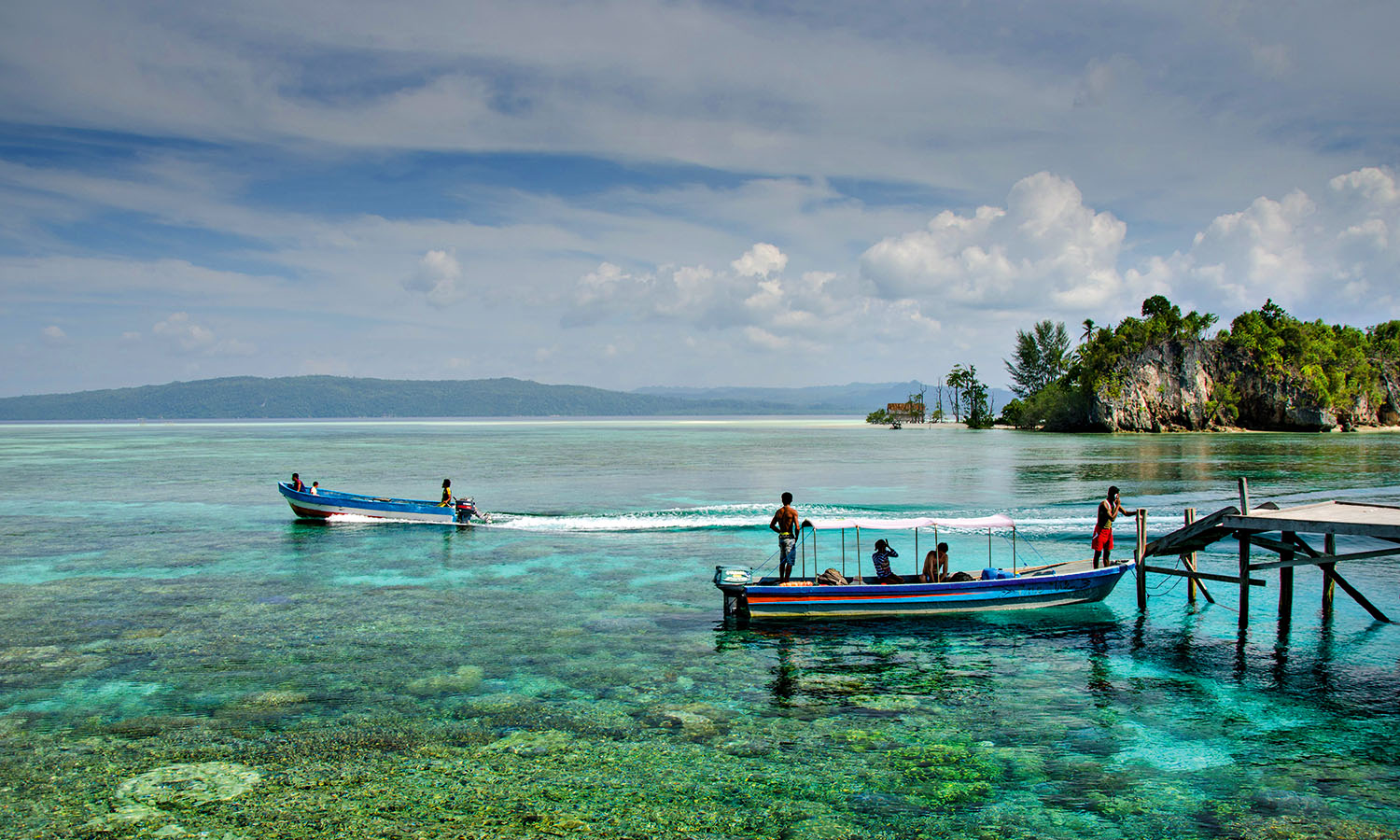

We make an attempt to snorkel in the blue water mangroves, but the tides are against us, and the boat has to turn back before it runs aground. Quietly, I’m relieved. Observing four-metre-long manta rays at a safe distance or harmless wobbegong sharks is OK by me, but I have no desire to get acquainted with a more vicious type of shark or, for that matter, a saltwater crocodile (although that is rare).
On our way through the channel we pass a timeless scene – a small child with her mother cooking over a fire. I can hear someone chopping down a tree in the forest that springs from this seemingly inhospitable limestone rock. I’m reminded of the view flying here – tiny islets and larger, jungle-topped land masses, rising from the gleaming sea like giant lizards. No signs of human habitation. Is Raja Ampat truly “the last paradise on earth”, as the tourist slogan says? Or have we just seen Eve, and heard Adam, both hard at work? Is paradise over?
Despite appearances, some of the Raja Ampat isles are very much inhabited. A showcase of island hospitality greets us one afternoon at Sawinggrai Village on Gam Island, where joyous and very well behaved children play music, sing and dance to welcome us. Playing games afterwards, the children seem totally blasé about the sea creatures all around them in the limpid water – that is, until a large squid swims into view and the excitement level amps up. Just as we are leaving, a rainbow divides the sky and a school of silvery flying fish leaps from the water, like a neon sign flashing on and off.
One vibrantly sunny afternoon after a similar welcome on Arborek Island, we enjoy the treat of a local-style lunch. Taro, cassava and fish wrapped in banana leaves are cooked on coals buried under sand. It seems that almost all of the island’s children watch closely as the pit is uncovered and the food unwrapped. We eat our feast serenaded by musicians.
While visitor numbers to Raja Ampat sit at around 20,000 a year, tourism is growing fast. The introduction of marine protected areas has put a halt on the capture of endangered species, which bring more dollars to the area while alive and swimming than when sold for food. The financial benefit is increasingly apparent in these village communities. I’m chuffed to think that the most spectacular sight of my time here – the beautiful rays circling Manta Sandy’s cleaning station – has a direct link to the less unusual, but no less cheering sight of happy, healthy children and their families singing and playing.
Get There
AirAsia flies to Denpasar in Bali with a stop in Kuala Lumpur from about US$508 return. Domestic flights with Garuda Indonesia to Sorong, with a stopover on the way, cost about AU$335 return. At the dock in Sorong, buy a US$9 ticket for the two-hour ferry to Waisai (the capital of Raja Ampat) on Waigeo Island. Your accommodation can usually arrange a boat transfer from there.
airasia.com
garuda-indonesia.com
Tour There
Liveaboards are the traditional way to tour. These range from local enterprises, such as the KLM Insos Raja Ampat (from US$704 for a seven-day trip) to extremely luxurious options such as the yacht Lamima (from US$11,600 for seven nights).
stayrajaampat.com
lamima.com
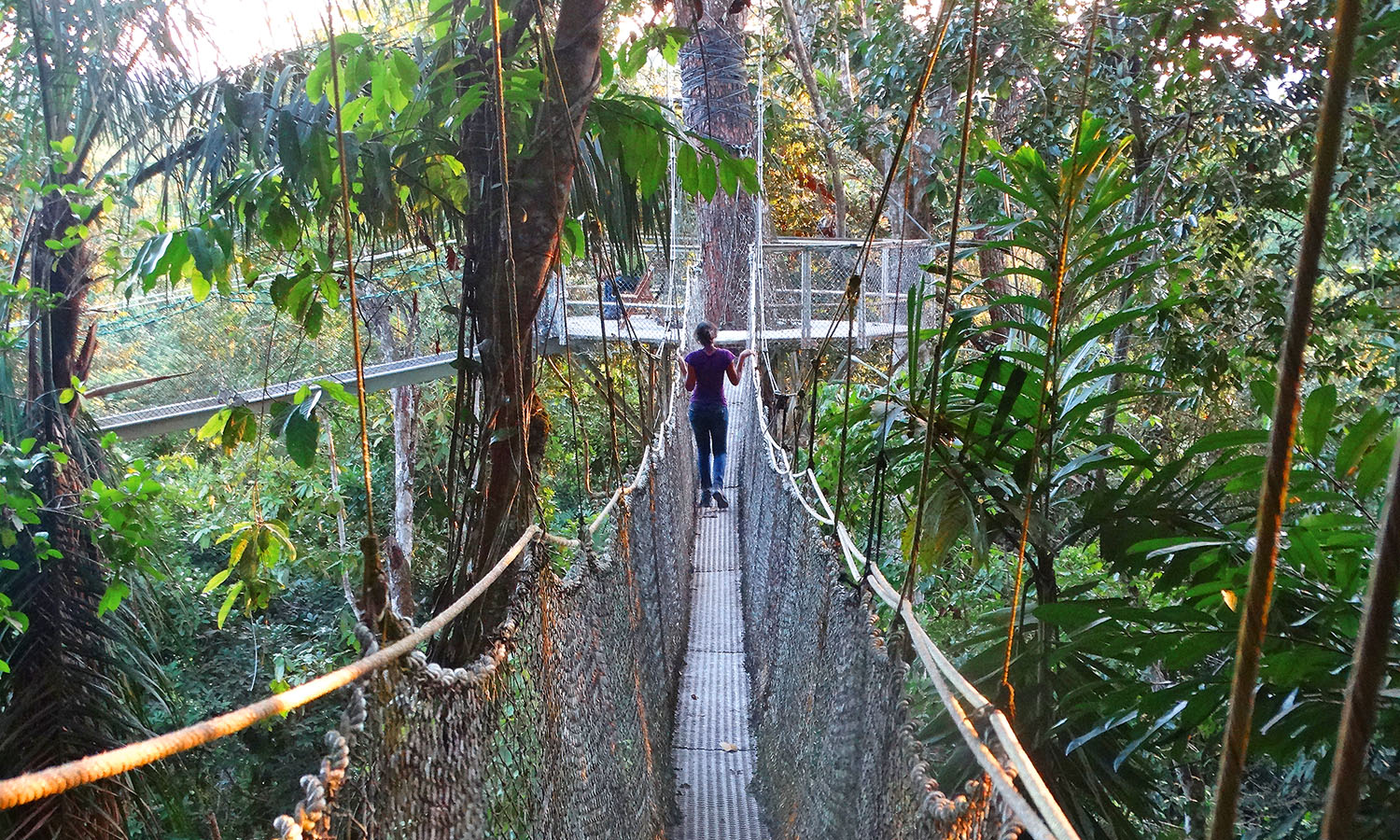

Making Wild Tracks
Jump in a 4WD and roll into the jungles of a little-explored South American nation.
When it comes to pointing out countries on a map, Guyana is one that would likely have the fingers of even the most well-travelled of explorers hovering in midair. The compact nation sits on South America’s North Atlantic coast, wedged between Venezuela, Brazil and the equally obscure Suriname. And it’s an ecotourism gem, with few visitors to spoil the adventure.
In 14 days, many of them spent behind the wheel of a 4WD, you can explore this country’s rugged interior, a land of jungles and savannas. Start in the capital of Georgetown, where a Caribbean vibe beats against the crumbling British and Dutch colonial architecture before, quite literally, taking off. At 228 metres, Kaieteur Falls is the world’s largest single-drop waterfall – it’s five times taller than Niagara – and it’s best seen on the inbound charter flight. Once you’ve arrived, settle in to enjoy the outstanding microclimate of golden frogs, tank bromeliads and the stunning cock-of-the-rock, a tangerine-plumed bird with a head resembling a slice of citrus fruit.
The next day it’s time to take to the road. Along the way you’ll visit the Iwokrama rainforest (one of four remaining untouched forests in the world), following its suspended walkways through the canopy to spot rare birds and monkeys, hike at dawn to the tops of mountains, experience life in an Amerindian community, glide along a river looking for giant river otters and the biggest lily pads in the world, and safari across the grasslands on the hunt for giant anteaters.
Throughout the journey, your accommodation, meals and tours will all be organised in advance, so all you need do is follow the map and take in every aspect of South America’s best-kept secret.
The 14-day self-drive Guyana Nature Experience tour with Wilderness Explorers costs about AU$7550 a person, based on two people sharing a vehicle.
wilderness-explorers.com
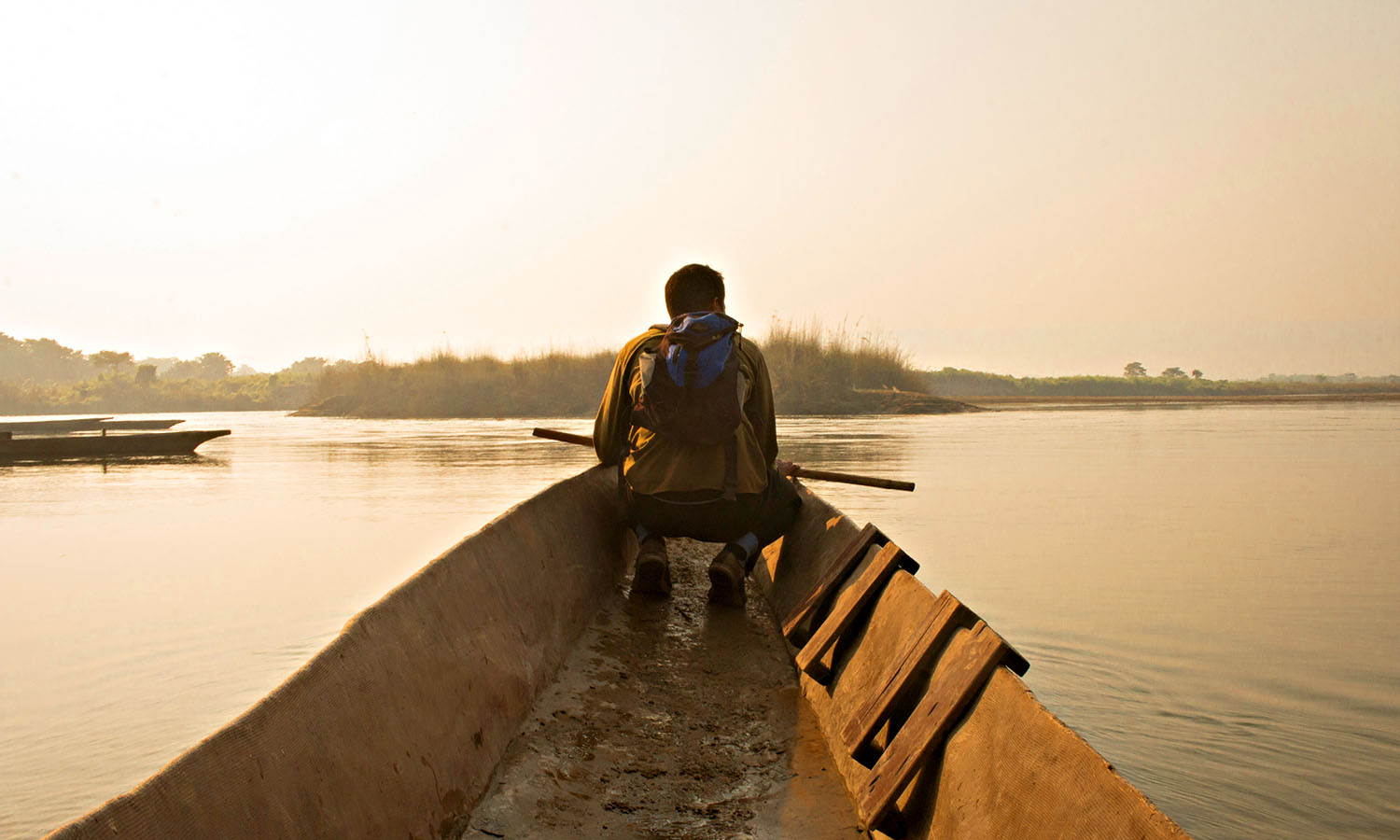

Fantastic Beasts
Nepal’s Chitwan National Park is home to some of the world’s rarest creatures. Tate Zandstra follows their footsteps into the Nepalese jungle.
Photography by Tate Zandstra
“Here are the pug marks of the tiger,” whispers Tulosi. The veteran guide is crouched on the trail, with soft morning sunlight burning off the fog and elephant grass towering over him. The prints are the width of my hand. “He was here this morning, maybe an hour ago.” Standing, Tulosi begins following the tracks. “This is a big male – 200, maybe 230 kilos,” he says, still whispering. In the stillness of morning, I feel a thrill – a wild tiger recently walked where I now stand.
“How far away is he now?” I ask.
“Forty or 50 metres,” Tulosi replies. “He is probably sleeping in those small trees because it is cool.” We stand and observe the spot. Finally, I ask what would happen if we followed the tiger into the trees. Tulosi glances at Sagar, his junior guide, and smiles. “I think the tiger would run away,” he says, “but we would never hear him.”
I am in Chitwan National Park, in the swampy Nepali lowlands known as the Terai. Thanks to ecotourism and law enforcement combating poaching, the national parks of Nepal, Chitwan and Bardia have recently won acclaim for the increasing populations of both tigers and rhinos. Even so, such is the elusiveness of these big cats that, until this moment, I dared not hope for so much as a paw print. As it happens, we track three more tigers during our journey, including a female with two cubs.
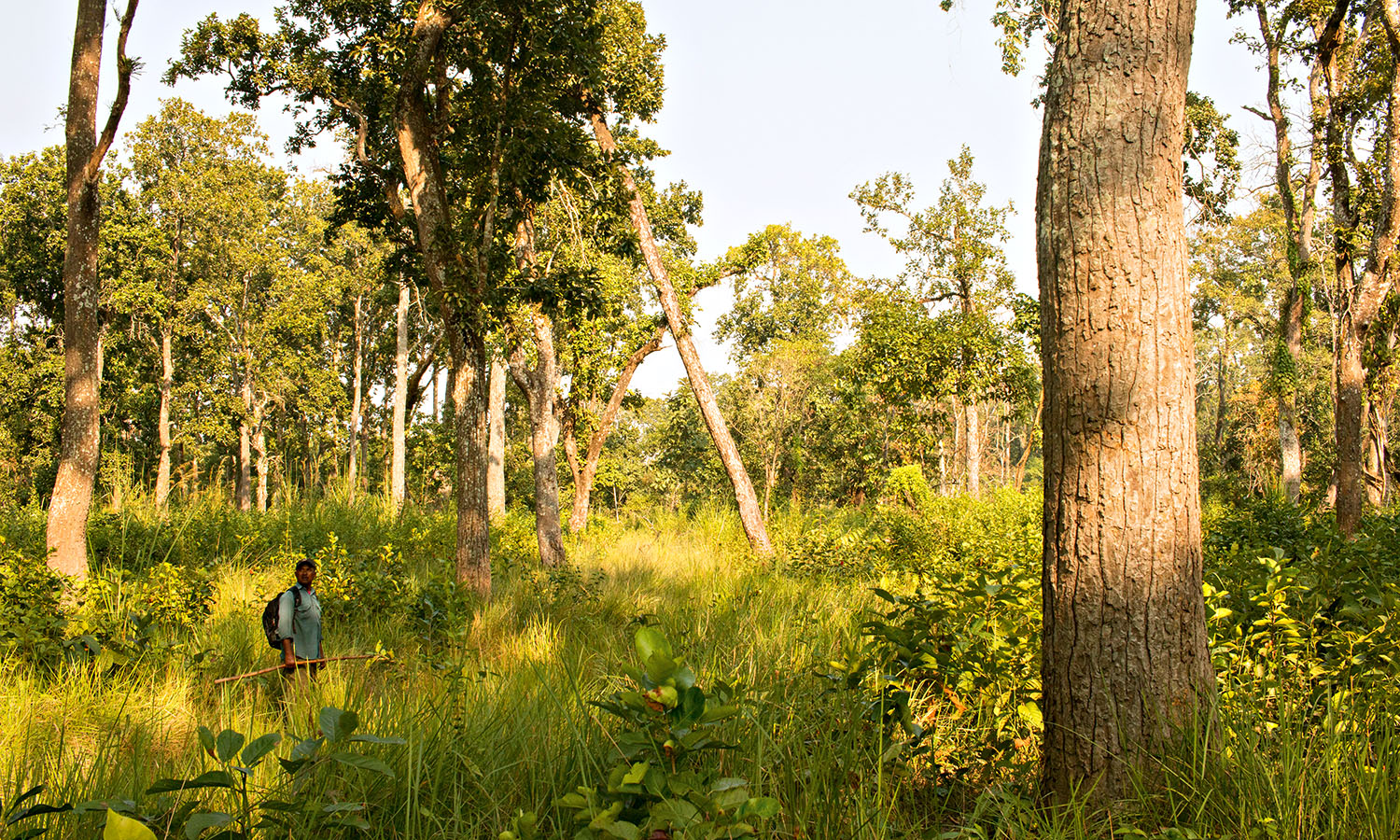

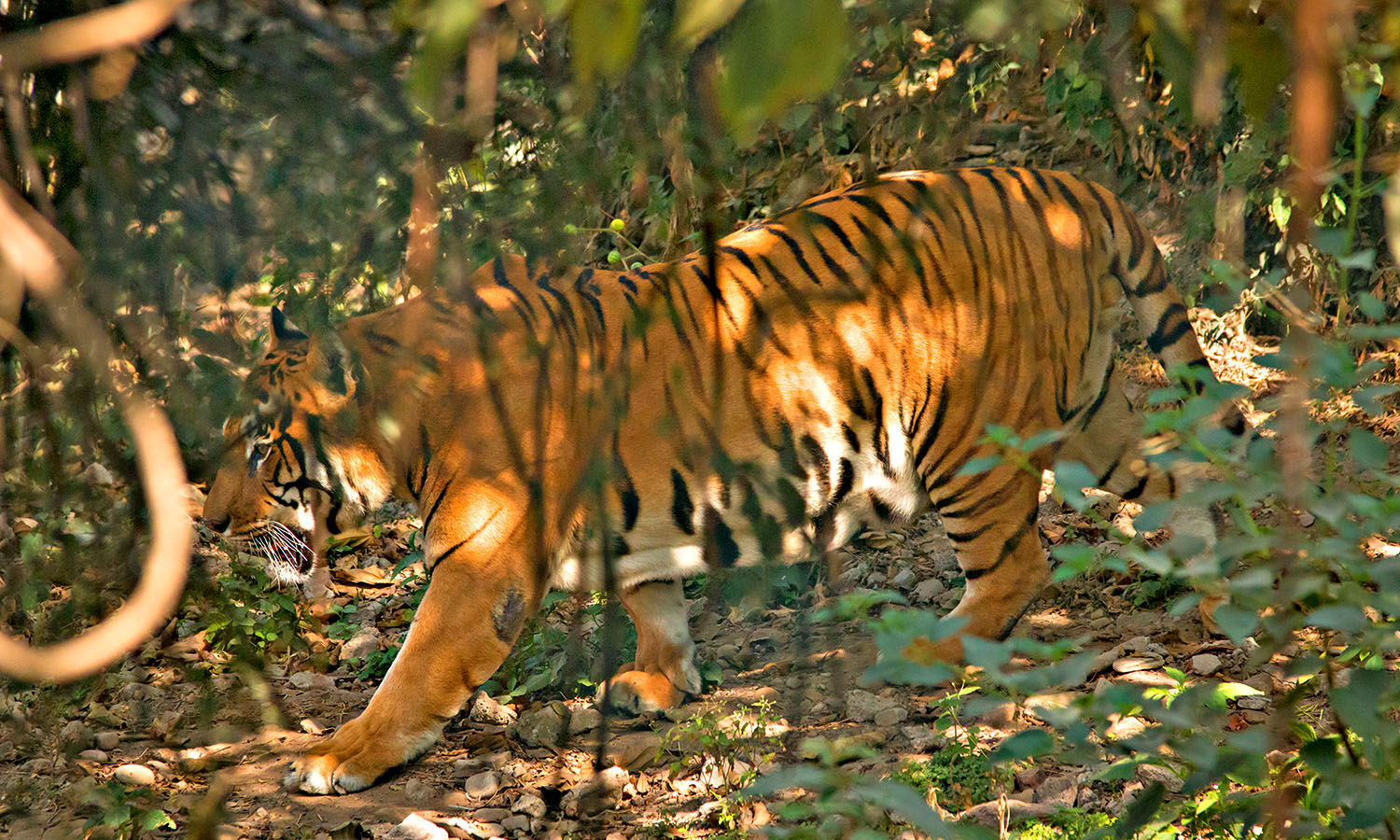

Late in the day, Tulosi halts. He’s spied a post hole-sized track flooding with groundwater. “Five minutes ago there was a big rhino here,” he announces, scanning the dense jungle. The rhinoceros, considered the most dangerous animal in the Terai, is the other star attraction here. Tulosi has lost two uncles to these two-tonne beasts. As dusk approaches, the animals are waking up.
We listen. But for cicadas keening, there’s silence. Something in the air changes; I hear wood splintering and have the overwhelming sense that an immense animal is tearing through the forest. Trees shake and monkeys screech. I hear mud sucking at giant feet as the crashing recedes.
“Come!” Sagar commands, darting down a game trail. I catch up to him crouching under cover on a berm overlooking the riverbank. The rhino emerges below us, 20 metres away. It snorts, holding its head high, looking for enemies in the jungle gloom.
Tulosi appears beside me, beckoning as he slides down the berm. Suddenly, he turns. “Run! Run!” he yells, and claws back up the steep, sandy trail. I glimpse the rhino, charging straight at us, covering ground at a terrifying pace. Then I am beside Sagar, who beats the ground with his walking stick.
The rhino stops 10 metres away, gouges furrows in the ground, then turns and sprints for the river. Tulosi is right behind him. The fear of moments ago forgotten in the chase, we run recklessly, following the huge creature. It smashes into the water, scattering crocodiles in the shallows.
The rhino reaches the far bank and turns in the orange glow of sunset, looking indignant yet majestic. “That was very scary!” Tulosi says, laughing. “How much danger were we in?” I ask. “Oh,” shrugs Tulosi, “very dangerous, he could have killed us.” Then he turns casually and walks toward town.
Get There
AirAsia flies from Sydney to Kathmandu in Nepal from US$745 return. Fly on to Bharatpur Airport with Buddha Air from US$210 return.
airasia.com
buddhaair.com
Tour There
Sauraha is the closest town to the park and the launch point for safaris. Stay at Hotel Jungle Vista and the owners, brothers Ram and Ramesh Silwal, can arrange a tour with guide Tulosi Raot. Two-night, one-day safaris start from AU$200.
hoteljunglevista.com
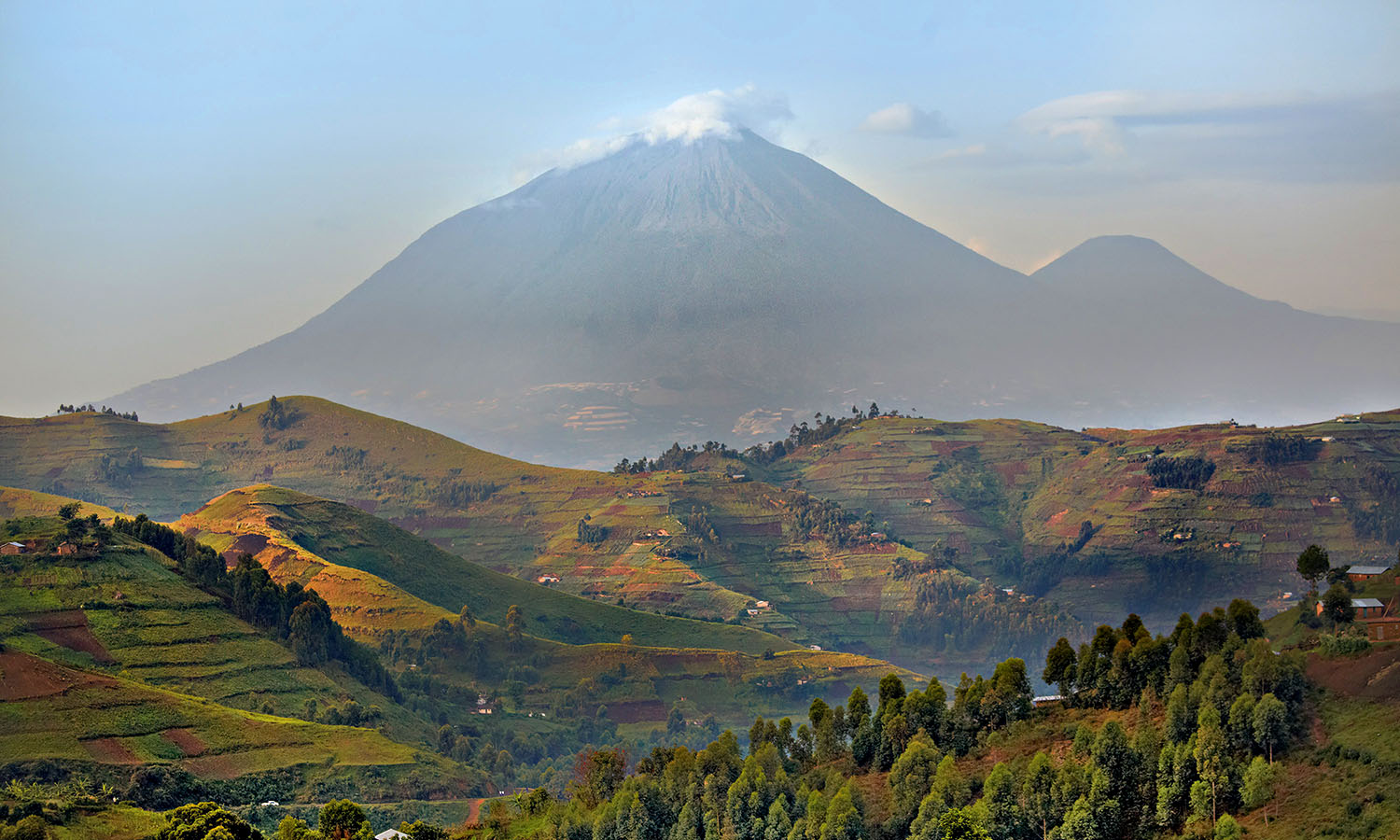

Meet Your Ancestors
Take a two-wheeled journey to discover Rwanda’s remotest regions and visit the country’s famous mountain gorillas.
Contemplating trekking into the wilds of Rwanda to spy the country’s famous mountain gorillas? There’s a way to have an even better experience in this fascinating nation. UK-based company the Slow Cyclist offers an epic eight-day adventure. Spend two nights acclimatising to altitude and conditions in Kigali before embarking on the first of four strenuous – Rwanda didn’t earn its nickname, the Land of a Thousand Hills, for nothing – but ultimately fulfilling days pedalling from the capital to Rubavu on the border of Congo. At times you’ll ride on bitumen roads, while elsewhere the trail will be red dirt, but if it all becomes a bit much you can always opt to jump in the support vehicle. The best part is this tour travels through regions of remote Rwanda few travellers ever experience, rolling past tea estates, sprawling lakes and smoking volcanoes.
The group size is small – just 12 (or up to 20 on a charity ride) – and the regular tour host is Michael Newhouse, a Brit who’s lived in East Africa since 2012. On each ride there’s also a number of local cyclists, guides and drivers whose knowledge of the culture is second to none. This is part of the ethos of the Slow Cyclist: to share places company founder Oli Broom loves with proper travellers. Broom was a chartered surveyor when, in 2009, he chucked in his job to cycle from London to Brisbane to watch the Ashes – it took him 412 days. After that adventure, he worked in Kigali for two years before moving back to London to establish the Slow Cyclist.
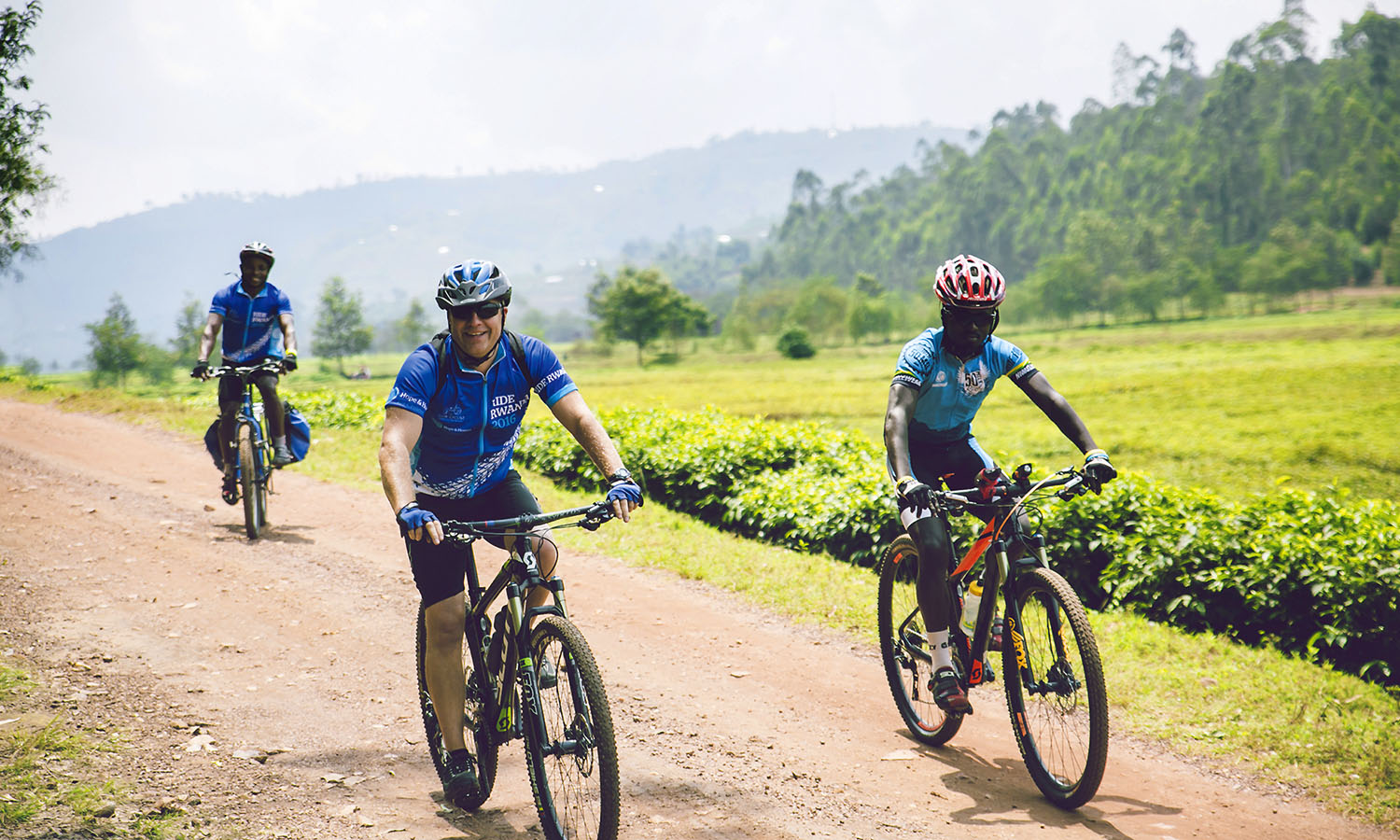

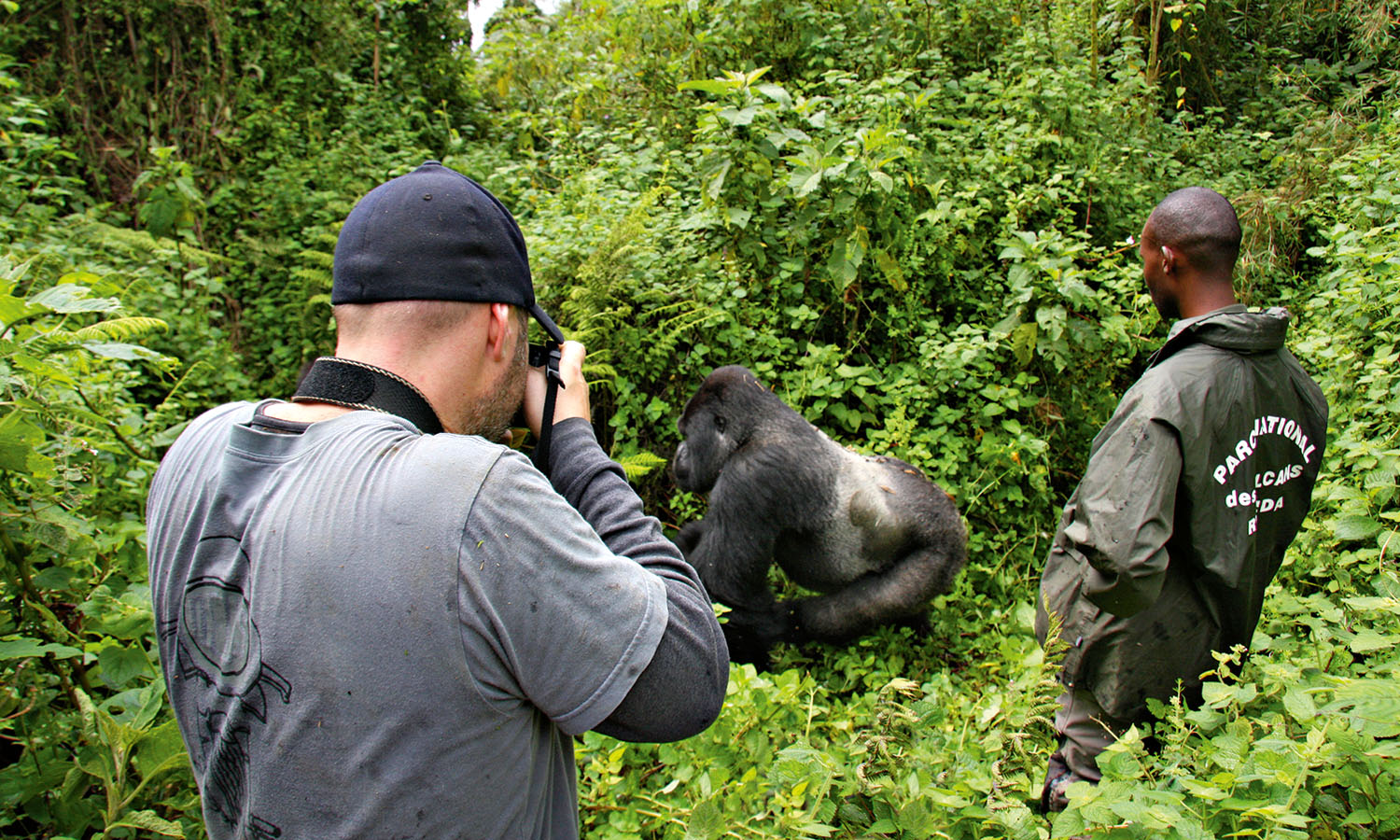

The zenith of this experience comes mid-tour. It’s billed as a rest day, but you won’t be putting up your feet. Starting early, you’ll trek through thick vegetation and along steep trails into Volcanoes National Park in the hope of finding one of the park’s 10 families of habituated gorillas. Locating them can take anywhere from an hour to eight, but when they come into view, all that hard work is rewarded. This is a rare opportunity; it’s estimated there are only about 880 mountain gorillas living in the wild and only eight park passes are issued per group in any one day. You’ll sit quietly for an hour and observe these incredible primates, thought to have split from their common ancestor to humans and chimps about nine million years ago, before heading back to camp.
The last day is a rewarding 90 kilometres back in the saddle, finishing at Lake Kivu, one of the Great Lakes. You’ll ascend 1390 metres along the base of a chain of volcanoes before tackling the final 30-kilometre downhill run that ends on the shores of the lake for a refreshing, celebratory dip.
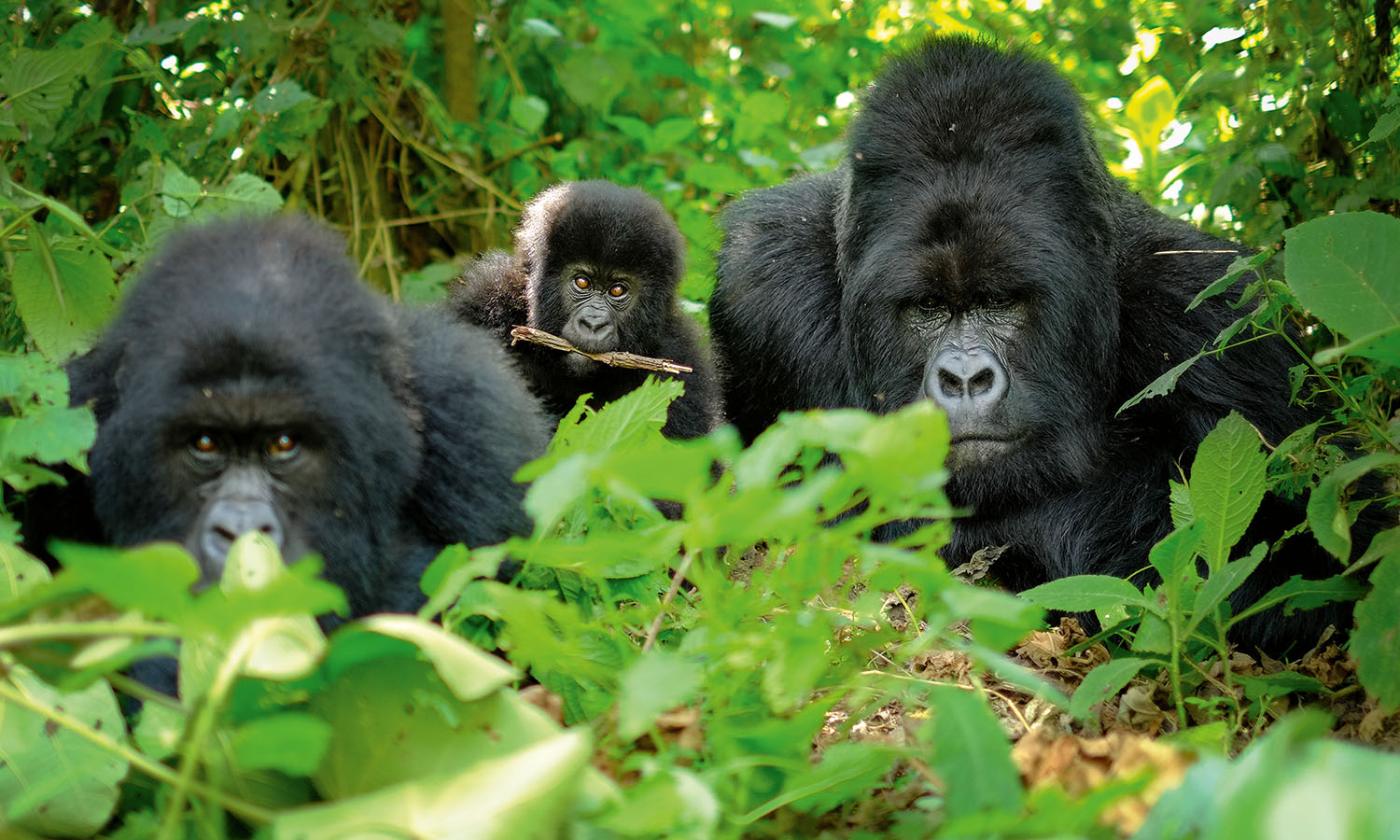

The Slow Cyclist has four scheduled Rwanda tours during 2017 – two small group tours and two charity challenges, which involve riders donating an extra amount of money to a chosen cause. The group tours cost about US$2643, including airport transfers, bike and gear hire, guides, accommodation and most meals. Gorilla trekking costs an extra US$881.
theslowcyclist.co.uk
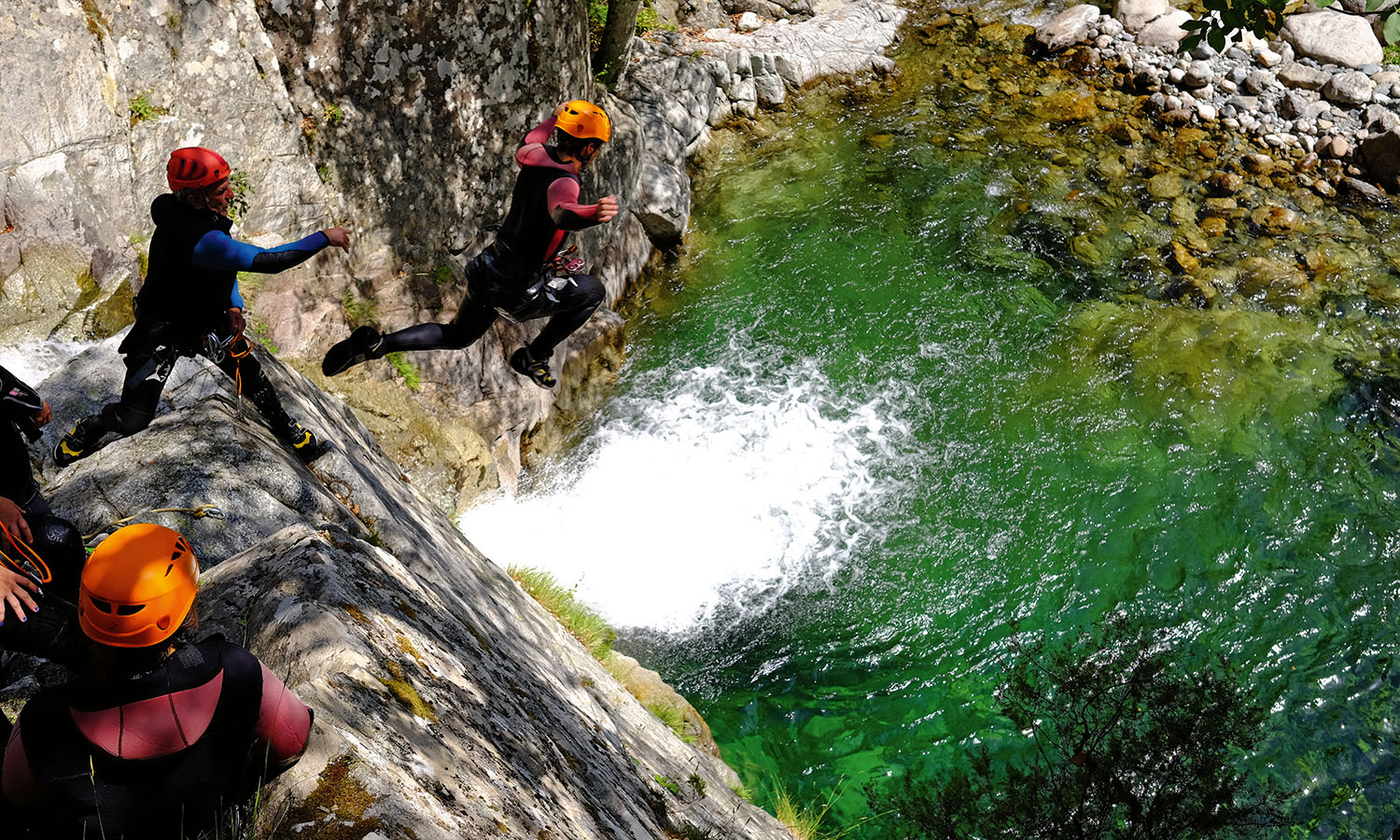

A Big Splash
Slip, slide and dive through the mountainous French island of Corsica.
When you think about adventure, chances are Corsica isn’t a natural segue. The Mediterranean island is best known as the birthplace of Napoleon, but beyond its picturesque bays and the capital of Ajaccio is a rugged landscape created by a single chain of granite peaks. Most travellers looking for an adventure would head straight for the GR20, one of the continent’s most popular and toughest hiking trails. Take it on and you’d be putting one foot in front of the other for 15 days to cover its 180-kilometre length and 10,000 metres of height variation.
Thankfully you can see the incredible highs and lows of the island’s interiors in a much easier way. Agnès and Pascal, both mountaineers and guides, set up Altipiani in the Corsican mountains and now run multiday canyoning tours. For between three and five hours each day you’ll explore the peaks and valleys from the water. There’ll be abseiling, tobogganing, zip-lining and plunging from the tops of cliffs into the emerald pools below at four different sites. You don’t need any specific experience; just the ability to swim, a head for heights and a hankering to discover Corsica in a completely different way.
The seven-day Altipiani canyoning trip starts at about US$745 for the camping option. You can also choose to stay in small hotels or B&Bs (about US$948). Prices include accommodation, meals, guides, equipment and transport from Corte.
altipiani-corse.com
SOLD OUT
Tags: canada, Corsica, gorillas, guyana, indonesia, Manitoba, nepal, Raja Ampat, Rwanda, Tundra camp Canada
 (
(




